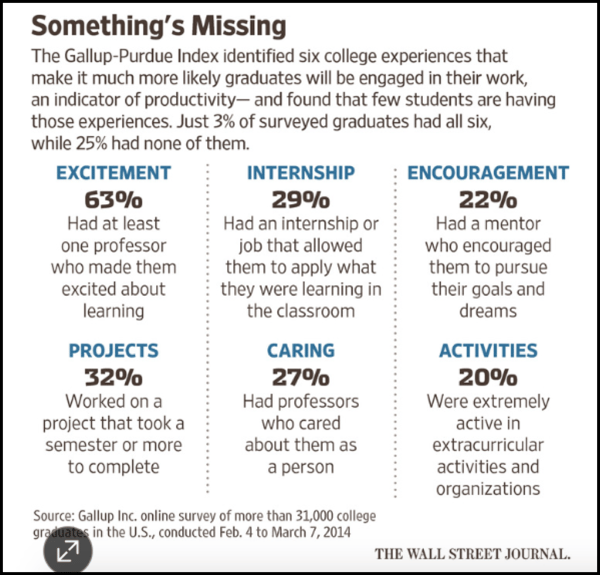Published on
Above the Noise: The Higher Education Highway (Part 2)

This is the second installment in a three-part series by Kenneth Hartman exploring what it takes for an institution to reinvent itself for long-term stability in today’s postsecondary marketplace. In the first installment, Hartman discussed the importance of institutions having both the Will and the Way to successfully transform. He also outlined the first of the three key ingredients to the Way: People. In this second installment, he will explore the second: Product.
Product
In 1906, the Carnegie Foundation for the Advancement of Teaching proposed the Carnegie Unit as the basis for a pension program for retiring faculty. By 1910, nearly all colleges at the time had adopted CU as a measure of course work. Soon thereafter, and still today, completion of 120 Carnegie Units (semester hours) serves as the gold standard for programs and as the accreditations requirement for awarding a bachelor’s degree.
At one point, perhaps, the 120 CUs meant a learned individual. Today, however, at many institutions it represents a hodge-podge of credits and courses with little or no linkage. Students often select required general education courses like they are ordering from a Chinese takeout menu, often basing their selection more on convenience (e.g., avoiding courses offered on Fridays) and not on whether one offering actually connects with other. In general, we, as educators, have done a poor job of connecting the dots for our students when it comes to program offerings.
Case in point: Harvard University, who started one of the first general education elective programs after World War II, released a faculty committee report last spring highly critical of its Gen Ed offering, stating “it is failing on a variety of fronts” including allowing students to fulfill the requirement by choosing from a list of over 574 courses. A major revision of their undergraduate curriculum is currently underway.
Sure, we say we connect the dots, as evidenced by a recent Gallup report showing that the purpose or mission statements of the more than 50 higher education institutions that participated in this study shared “striking similarities, regardless of institution size, public or private status, land-grant status or religious affiliation, or for-profit or not-for-profit status.” Examples: “We prepare the leaders of tomorrow,” “We nurture lifelong learners” or “We aim to have a global impact, while serving our local community.”
However, that same Gallup report found that few institutions referred to their “tangible outcomes” and urged institutional leaders to “establish unique values based on clear outcomes.”
Ironically, there has never been a time in recent memory when the liberal arts or humanities were more important then today. Name any problem in the world (hunger, terrorism, climate change, economic instability, etc.), and the most likely solution involves the integration, application and communication of knowledge from history, mathematics, geography, religion, social sciences and biological sciences.
Many prospective students, their parents and future employers seek the same product—namely, a degree that connects the dots, in a shorter time period, and for less money. In other words, an accelerated, competency-based degree program.
It is my belief that the leading 21st-century bachelor’s degrees will be true three-year degrees (requiring 90 semester hours or less) that can demonstrate how critical competencies are assessed, adapted and forged to meet market demands, be it on-campus, online, or in some hybrid model. The successful educational process will not just produce graduates who are competent on certain marketable skills, but graduates who can demonstrate various ways to think. The operative words being “demonstrate” and “think.”
Again, as the Gallup report suggested, it’s critical we “establish unique values based on clear outcomes.” The same could be said for associate degrees and, increasingly, graduate degrees.
So-called alterative credentials should also be considered by colleges nearing or at MM3 to MM5. Merely producing undergraduates with the four traditional data points (name/brand of college, type of degree, earned grade point, major) after four to six years of schooling will not sufficiently demonstrate key competencies to employers and, therefore will not stop the forward progress towards the next MM.
At the same time optimizing and prioritizing your program portfolio is essential, including creating a comprehensive inventory of your current portfolio, identifying which existing programs meet market demand while also supporting your institutional objectives, and determining the market opportunities for new programs.
Equally important is affordability, which means controlling all costs, including the rapidly escalating cost of instruction—the biggest institutional cost. As institutions at MM 3-5 seek to build conscience on an accelerated, well-connected, competency-based degree program, they must seek ways to lower their cost of instruction. New pedagogical methods must be explored and, where possible, supported by technology to maximize and demonstrate student competencies led by critical thinking and problem solving.
Not lost in the conversation should be instituting policies and practices that encourage (or mandate) faculty use of digital and/or Open Education Resources. Electronic and digital versions of textbooks—as well as alternative approaches to accessing them through rental or OER—can save students thousands of dollars. The Maryland Open Source Textbook Initiative (MOST) saved 1,100 students at MD colleges nearly $130,000 in the Spring 2014 semester.
Forecasted advances in mobile technology, in particular, will provide institutions with a learning platform of unimaginable speed and versatility. As early as 2017, we’ll see hundreds of intelligent apps affording personalized learning, digital lifestyle coaches to increase retention, learning objects coming alive in virtual reality, and 5G speeds to enable you to download an entire movie (or lecture) in less than one second.
At the end of the day, the product must serve as the single most important differentiator for institutions at MM 3-5. It should, as Gallup stated, “tell the world what the institution is and what it will deliver.”
The private sector learned decades ago that there were multiple audiences for their product’s brand if they offered different options, at different prices, to different customers. Marriott Hotels, for example, with over 20 different brands, found that some guests prefer to stay at their top-tier hotels (e.g., JW Marriott, Ritz Carlton) and pay $500-$700 a night for their 5-star restaurants, 24/7 concierge, bed sheet turndown service and a mint on your pillow each night. Other customers prefer staying at a Marriott Courtyard at $100-$150 a night, where a snack bar may be available, the front desk manager also serves as your concierge, and you turndown your own sheets and bring your own mints. Still too much product for your budget? Then try staying at Marriott’s Fairfield Inn and Suites for around $100 per night. Of course, earn Marriott points at all their properties.
Most colleges and universities, on the other hand, have one basic product/brand and charge one price (minus discounts), in spite of changing demographics and heightened demands for more meaningful and affordable options.
Higher education is the only major sector of our economy where greater competition leads to higher costs. Imagine what would happen to the lodging and hospitality sector if they raised their prices, at a time when there were fewer business travelers and more hotels being built.
Greater product differential, leading to greater cost savings, can be found under the final and third P: Process
This is the second installment in a three-part series by Kenneth Hartman exploring what it takes for an institution to reinvent itself for long-term stability in today’s postsecondary marketplace. In the final installment, he will explore the third P: Process.
You can reach Ken Hartman by email at kenhartman@kenhartman.com.
Click here to download the Institutional Maintenance Check List
Author Perspective: Analyst




